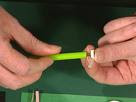
Quilling, or paper filigree, is an ancient art that is slowly being revived after almost dying out at the end of the 1800's.
It is believed Quilling has been practiced since ancient Egyptian and/or 4th Century Grecian times. Although they obviously would not have used paper in the 4th century, it is believed the Greeks used thin metal wires to decorate containers, especially boxes, and Egyptian tombs have been found containing similar wire shapes akin to modern quilling.
While some sources speculate that quilling originated in Ancient Egypt, others connect the craft with the invention of paper in China around 105 AD. In any case, the first known quillers were members of cloistered religious orders in Europe during the Middle Ages who used individual bird quills as a rolling tools. Later on, 15th-century nuns collected gilt-edged parchment that fell off bibles to quill decorative designs for medallions. With the wider availability of paper, French and Italian nuns achieved more intricate work in the 16th-and 17th-centuries, decorating relics and religious images with quilling as ornamnetation. Walls and altars of poorer churches displayed these icons and backgrounds quilled with gilded or silvered paper, mostly indistinguishable from genuine gold or silver filigree work.
In the late 18th- through 19th-centuries, Quilling became more popular as paper became less expensive and more widely available. As it became popular for decorative crafts, it was thought to be a suitable hobby for popular ladies and "ladies of leisure" in England. From there, the hobby was brought to the American Colonies and to New England.
For unclear reasons, quilling's popularity faded during the late 1800s and failed to make a resurgence until the 1950s, sometimes deccorating paper greeting cards or adorning framed documents. Without preservation, quilling is just as fragile and fleeting as other paper crafts.
Many museums around the country and abroad have examples of antique work either on display or stored behind the scenes.With the introduction of modern paper and techniques, Quilling is currently enjoying a wall deserved revival.










